The planting possibilities using succulents are endless. The different colors, textures, and habits make the most interesting containers and troughs. Succulents are also a beautiful addition to rock gardens. With a wide variety of bloom times, there is always something with color. Succulents are easy to care for if you know a few simple rules.
Zones
Hardy succulents are USDA Plant Hardiness Zone 3-9 unless otherwise labeled. Plants shipped in early spring are dormant. Therefore, they will appear dull in color and have some dry edges. This is normal; when placed in sunlight, they will intensify in color.
Light
Most varieties need at least half a day to a full day of sunlight. Some afternoon shade is recommended in extremely hot areas.
Planting
Remove plants from their pots and plant them, ensuring the soil level remains the same depth on the plant. Once established, your succulents will benefit from a layer of pebbles or pea gravel spread on the soil around the plant. This is also very decorative.

Soil
Succulents need well-draining soil. When planting in the garden, ensure the area drains well and is not in a low spot that would stay wet. You can purchase a soil mix for succulents or make your own potting mix with sand, gravel, or volcanic rocks for better drainage for container planting. The container you are planting in should have at least one drainage hole.
Watering
After planting, wait a week after repotting to water your succulent. Succulents do not like wet feet, so water thoroughly and allow the soil to dry slightly between waterings.
Fertilizer
Most succulents need very little fertilizer. Watering with a well-balanced fertilizer once a month will be all they need.
Source: simplysucculents.com
Links
- Succupedia: Browse succulents by Scientific Name, Common Name, Genus, Family, USDA Hardiness Zone, Origin, or cacti by Genus